Warehouse Management and its Impact on the Supply Chain
VerifiedAdded on 2023/03/30
|12
|2592
|391
AI Summary
This article explores the connection between warehouse management and the supply chain, highlighting the importance of effective management strategies. It discusses the impact of warehouse management on inventory control, customer service, and the use of technology. Current trends in warehouse management, such as the use of robots and increased operations, are also discussed. The article concludes with recommendations for future research and the implications of warehouse management on the supply chain.
Contribute Materials
Your contribution can guide someone’s learning journey. Share your
documents today.

SUPPLY CHAIN PAGE \* MERGEFORMAT 11
SUPPLY CHAIN
Students Name
Professor’s Name
Institution
Course
Date
SUPPLY CHAIN
Students Name
Professor’s Name
Institution
Course
Date
Secure Best Marks with AI Grader
Need help grading? Try our AI Grader for instant feedback on your assignments.
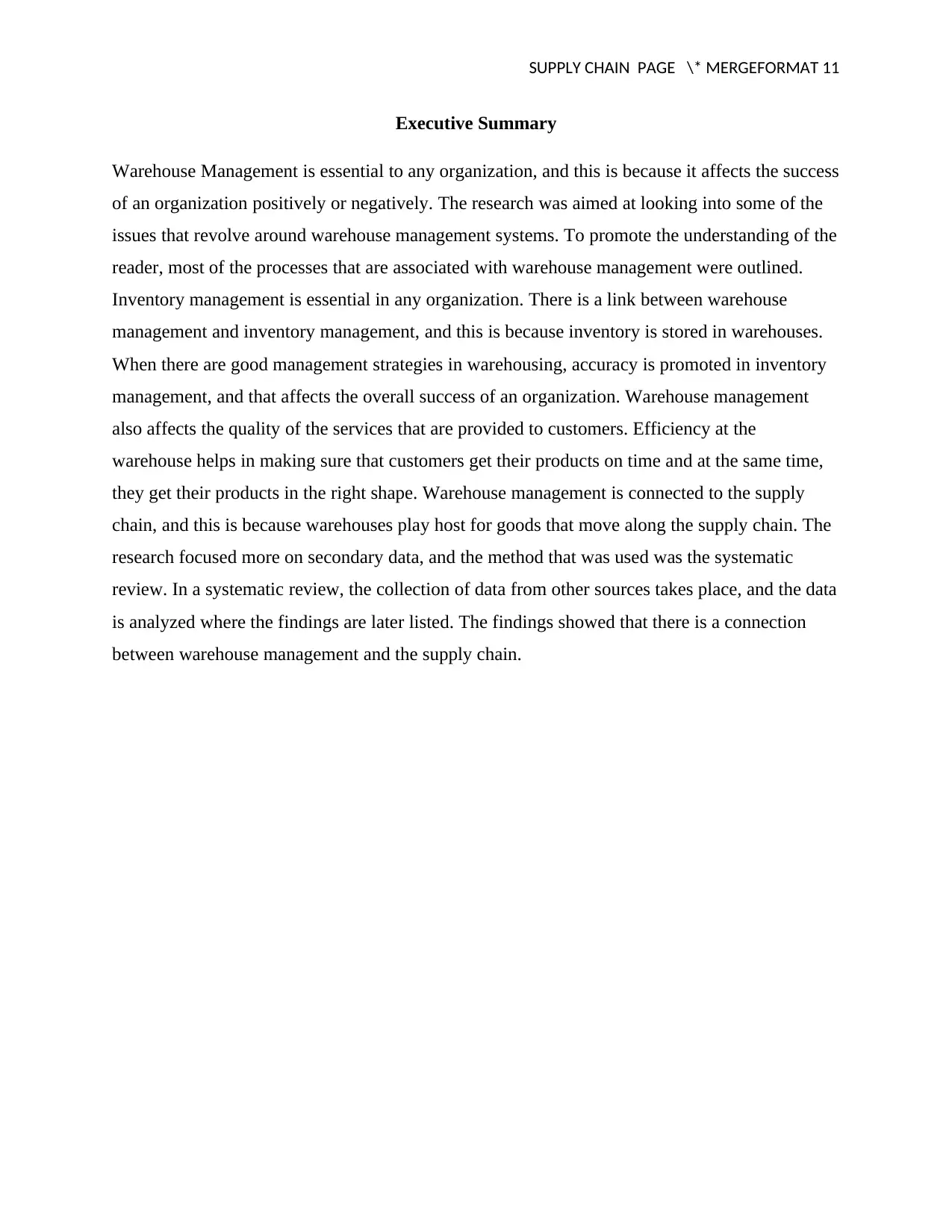
SUPPLY CHAIN PAGE \* MERGEFORMAT 11
Executive Summary
Warehouse Management is essential to any organization, and this is because it affects the success
of an organization positively or negatively. The research was aimed at looking into some of the
issues that revolve around warehouse management systems. To promote the understanding of the
reader, most of the processes that are associated with warehouse management were outlined.
Inventory management is essential in any organization. There is a link between warehouse
management and inventory management, and this is because inventory is stored in warehouses.
When there are good management strategies in warehousing, accuracy is promoted in inventory
management, and that affects the overall success of an organization. Warehouse management
also affects the quality of the services that are provided to customers. Efficiency at the
warehouse helps in making sure that customers get their products on time and at the same time,
they get their products in the right shape. Warehouse management is connected to the supply
chain, and this is because warehouses play host for goods that move along the supply chain. The
research focused more on secondary data, and the method that was used was the systematic
review. In a systematic review, the collection of data from other sources takes place, and the data
is analyzed where the findings are later listed. The findings showed that there is a connection
between warehouse management and the supply chain.
Executive Summary
Warehouse Management is essential to any organization, and this is because it affects the success
of an organization positively or negatively. The research was aimed at looking into some of the
issues that revolve around warehouse management systems. To promote the understanding of the
reader, most of the processes that are associated with warehouse management were outlined.
Inventory management is essential in any organization. There is a link between warehouse
management and inventory management, and this is because inventory is stored in warehouses.
When there are good management strategies in warehousing, accuracy is promoted in inventory
management, and that affects the overall success of an organization. Warehouse management
also affects the quality of the services that are provided to customers. Efficiency at the
warehouse helps in making sure that customers get their products on time and at the same time,
they get their products in the right shape. Warehouse management is connected to the supply
chain, and this is because warehouses play host for goods that move along the supply chain. The
research focused more on secondary data, and the method that was used was the systematic
review. In a systematic review, the collection of data from other sources takes place, and the data
is analyzed where the findings are later listed. The findings showed that there is a connection
between warehouse management and the supply chain.
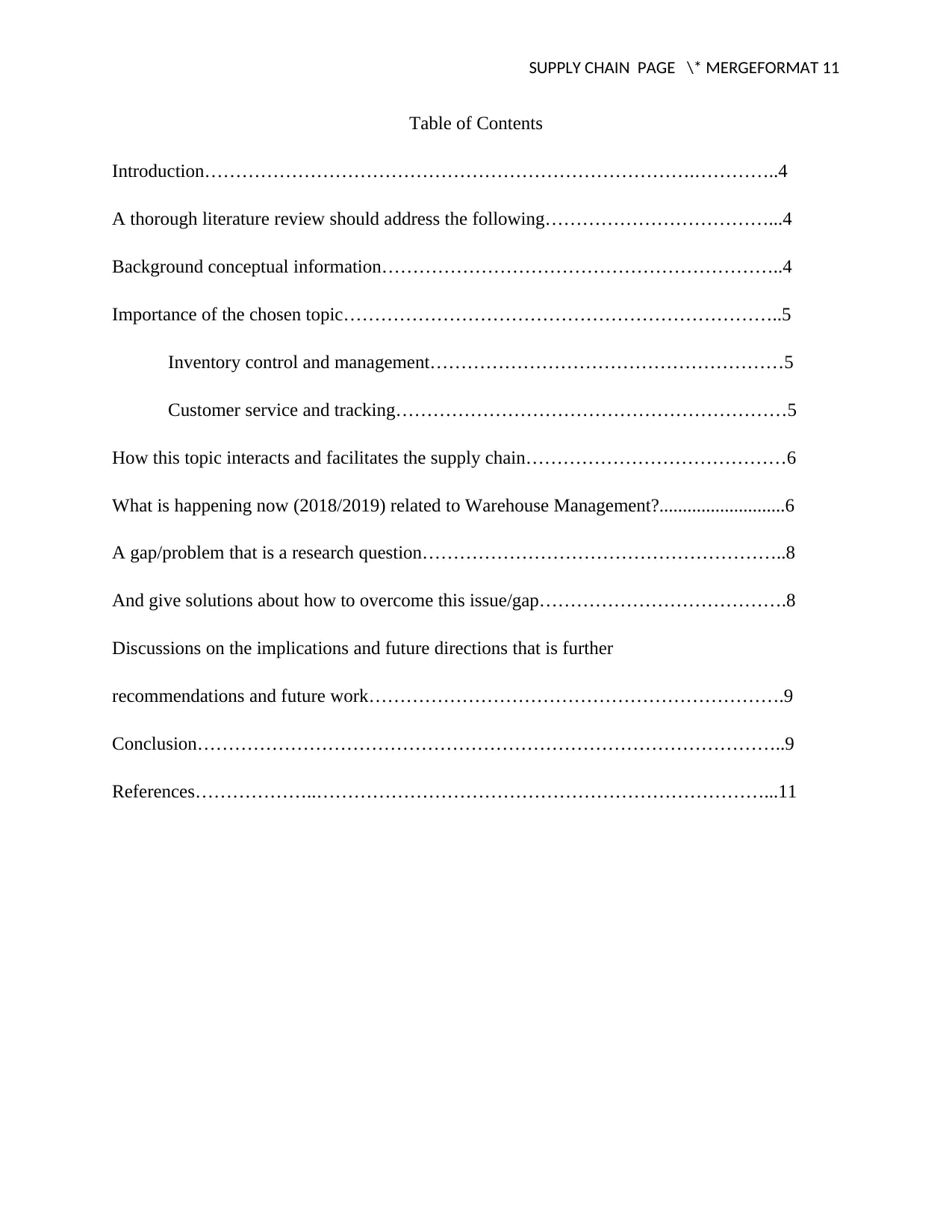
SUPPLY CHAIN PAGE \* MERGEFORMAT 11
Table of Contents
Introduction…………………………………………………………………….…………..4
A thorough literature review should address the following………………………………...4
Background conceptual information………………………………………………………..4
Importance of the chosen topic……………………………………………………………..5
Inventory control and management…………………………………………………5
Customer service and tracking………………………………………………………5
How this topic interacts and facilitates the supply chain……………………………………6
What is happening now (2018/2019) related to Warehouse Management?...........................6
A gap/problem that is a research question…………………………………………………..8
And give solutions about how to overcome this issue/gap………………………………….8
Discussions on the implications and future directions that is further
recommendations and future work………………………………………………………….9
Conclusion…………………………………………………………………………………..9
References………………..………………………………………………………………...11
Table of Contents
Introduction…………………………………………………………………….…………..4
A thorough literature review should address the following………………………………...4
Background conceptual information………………………………………………………..4
Importance of the chosen topic……………………………………………………………..5
Inventory control and management…………………………………………………5
Customer service and tracking………………………………………………………5
How this topic interacts and facilitates the supply chain……………………………………6
What is happening now (2018/2019) related to Warehouse Management?...........................6
A gap/problem that is a research question…………………………………………………..8
And give solutions about how to overcome this issue/gap………………………………….8
Discussions on the implications and future directions that is further
recommendations and future work………………………………………………………….9
Conclusion…………………………………………………………………………………..9
References………………..………………………………………………………………...11
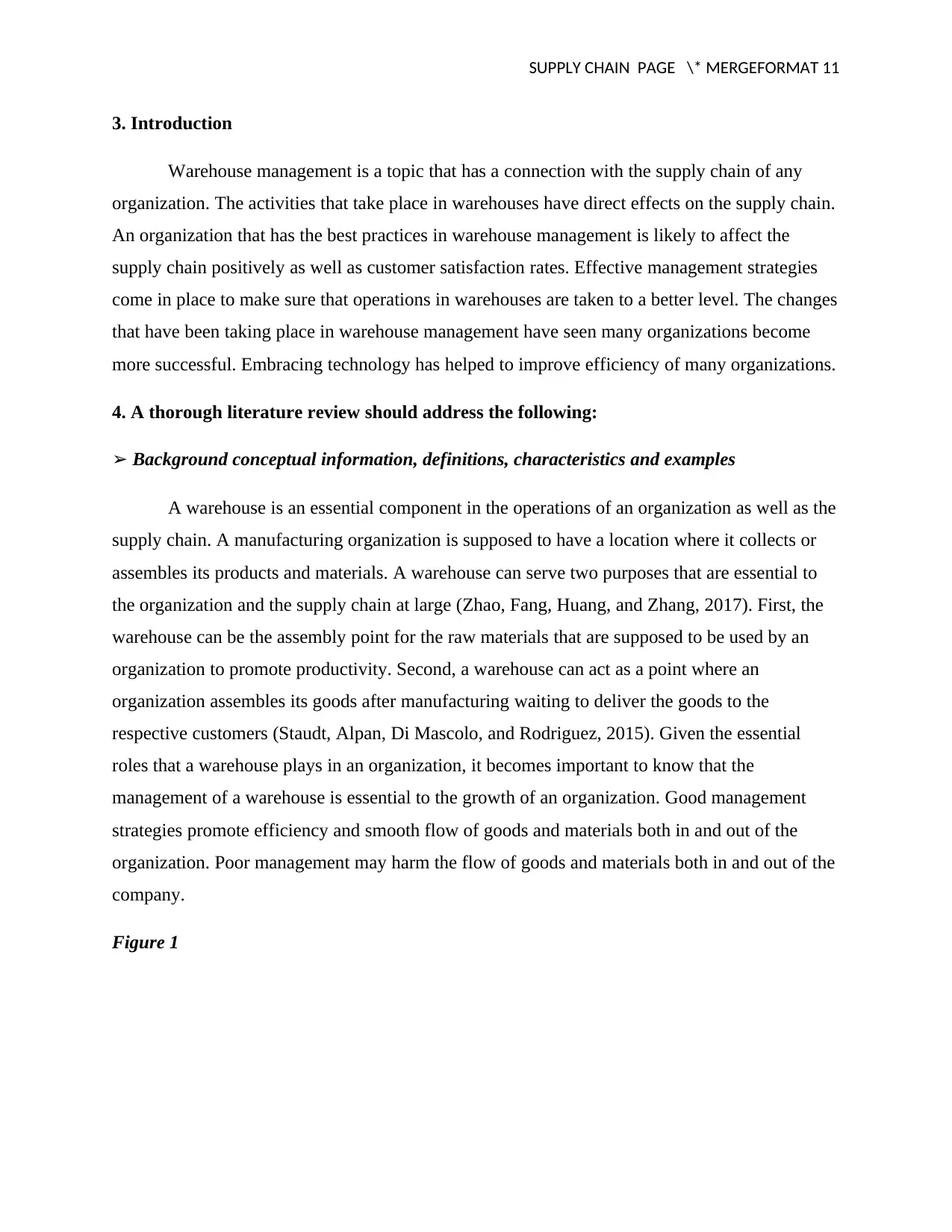
SUPPLY CHAIN PAGE \* MERGEFORMAT 11
3. Introduction
Warehouse management is a topic that has a connection with the supply chain of any
organization. The activities that take place in warehouses have direct effects on the supply chain.
An organization that has the best practices in warehouse management is likely to affect the
supply chain positively as well as customer satisfaction rates. Effective management strategies
come in place to make sure that operations in warehouses are taken to a better level. The changes
that have been taking place in warehouse management have seen many organizations become
more successful. Embracing technology has helped to improve efficiency of many organizations.
4. A thorough literature review should address the following:
➢ Background conceptual information, definitions, characteristics and examples
A warehouse is an essential component in the operations of an organization as well as the
supply chain. A manufacturing organization is supposed to have a location where it collects or
assembles its products and materials. A warehouse can serve two purposes that are essential to
the organization and the supply chain at large (Zhao, Fang, Huang, and Zhang, 2017). First, the
warehouse can be the assembly point for the raw materials that are supposed to be used by an
organization to promote productivity. Second, a warehouse can act as a point where an
organization assembles its goods after manufacturing waiting to deliver the goods to the
respective customers (Staudt, Alpan, Di Mascolo, and Rodriguez, 2015). Given the essential
roles that a warehouse plays in an organization, it becomes important to know that the
management of a warehouse is essential to the growth of an organization. Good management
strategies promote efficiency and smooth flow of goods and materials both in and out of the
organization. Poor management may harm the flow of goods and materials both in and out of the
company.
Figure 1
3. Introduction
Warehouse management is a topic that has a connection with the supply chain of any
organization. The activities that take place in warehouses have direct effects on the supply chain.
An organization that has the best practices in warehouse management is likely to affect the
supply chain positively as well as customer satisfaction rates. Effective management strategies
come in place to make sure that operations in warehouses are taken to a better level. The changes
that have been taking place in warehouse management have seen many organizations become
more successful. Embracing technology has helped to improve efficiency of many organizations.
4. A thorough literature review should address the following:
➢ Background conceptual information, definitions, characteristics and examples
A warehouse is an essential component in the operations of an organization as well as the
supply chain. A manufacturing organization is supposed to have a location where it collects or
assembles its products and materials. A warehouse can serve two purposes that are essential to
the organization and the supply chain at large (Zhao, Fang, Huang, and Zhang, 2017). First, the
warehouse can be the assembly point for the raw materials that are supposed to be used by an
organization to promote productivity. Second, a warehouse can act as a point where an
organization assembles its goods after manufacturing waiting to deliver the goods to the
respective customers (Staudt, Alpan, Di Mascolo, and Rodriguez, 2015). Given the essential
roles that a warehouse plays in an organization, it becomes important to know that the
management of a warehouse is essential to the growth of an organization. Good management
strategies promote efficiency and smooth flow of goods and materials both in and out of the
organization. Poor management may harm the flow of goods and materials both in and out of the
company.
Figure 1
Secure Best Marks with AI Grader
Need help grading? Try our AI Grader for instant feedback on your assignments.
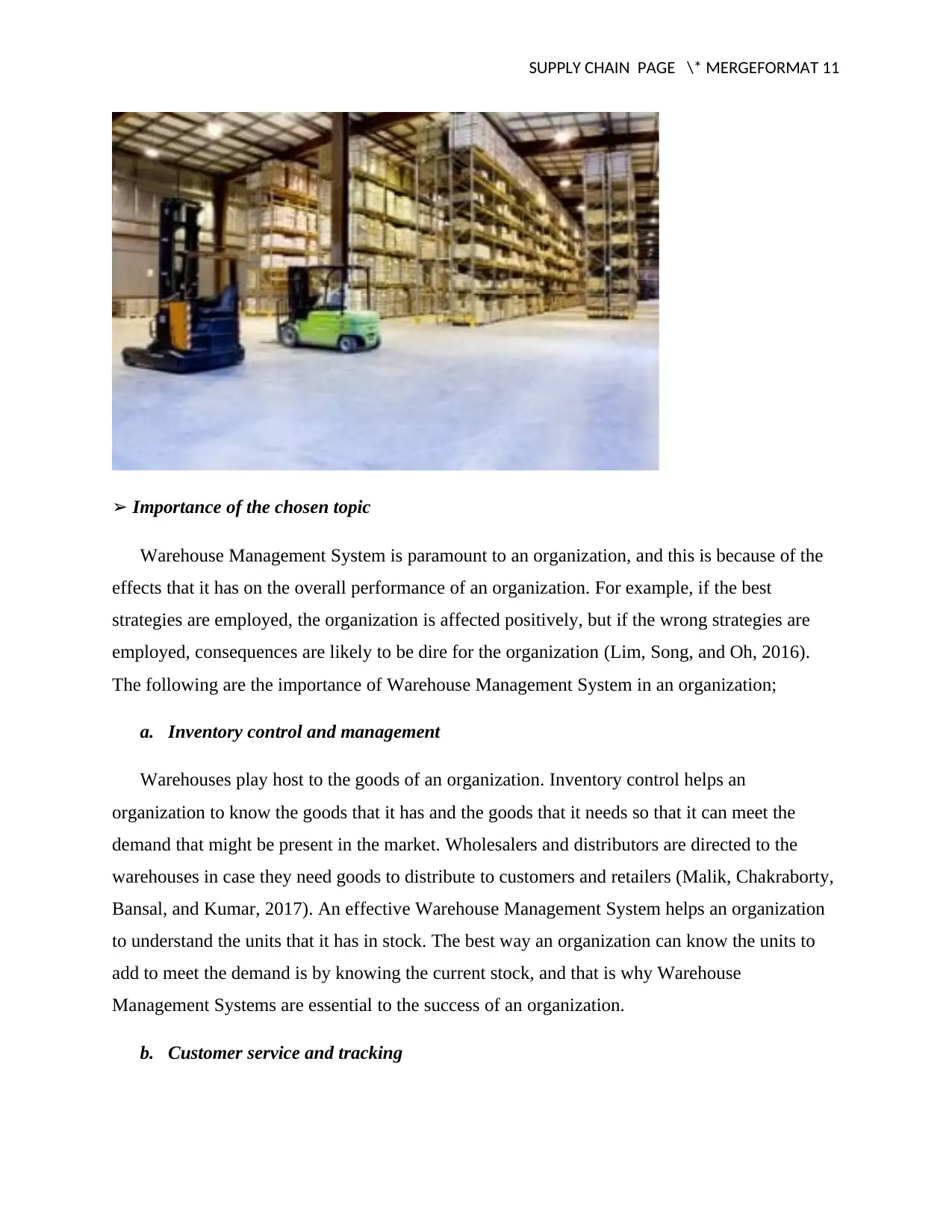
SUPPLY CHAIN PAGE \* MERGEFORMAT 11
➢ Importance of the chosen topic
Warehouse Management System is paramount to an organization, and this is because of the
effects that it has on the overall performance of an organization. For example, if the best
strategies are employed, the organization is affected positively, but if the wrong strategies are
employed, consequences are likely to be dire for the organization (Lim, Song, and Oh, 2016).
The following are the importance of Warehouse Management System in an organization;
a. Inventory control and management
Warehouses play host to the goods of an organization. Inventory control helps an
organization to know the goods that it has and the goods that it needs so that it can meet the
demand that might be present in the market. Wholesalers and distributors are directed to the
warehouses in case they need goods to distribute to customers and retailers (Malik, Chakraborty,
Bansal, and Kumar, 2017). An effective Warehouse Management System helps an organization
to understand the units that it has in stock. The best way an organization can know the units to
add to meet the demand is by knowing the current stock, and that is why Warehouse
Management Systems are essential to the success of an organization.
b. Customer service and tracking
➢ Importance of the chosen topic
Warehouse Management System is paramount to an organization, and this is because of the
effects that it has on the overall performance of an organization. For example, if the best
strategies are employed, the organization is affected positively, but if the wrong strategies are
employed, consequences are likely to be dire for the organization (Lim, Song, and Oh, 2016).
The following are the importance of Warehouse Management System in an organization;
a. Inventory control and management
Warehouses play host to the goods of an organization. Inventory control helps an
organization to know the goods that it has and the goods that it needs so that it can meet the
demand that might be present in the market. Wholesalers and distributors are directed to the
warehouses in case they need goods to distribute to customers and retailers (Malik, Chakraborty,
Bansal, and Kumar, 2017). An effective Warehouse Management System helps an organization
to understand the units that it has in stock. The best way an organization can know the units to
add to meet the demand is by knowing the current stock, and that is why Warehouse
Management Systems are essential to the success of an organization.
b. Customer service and tracking
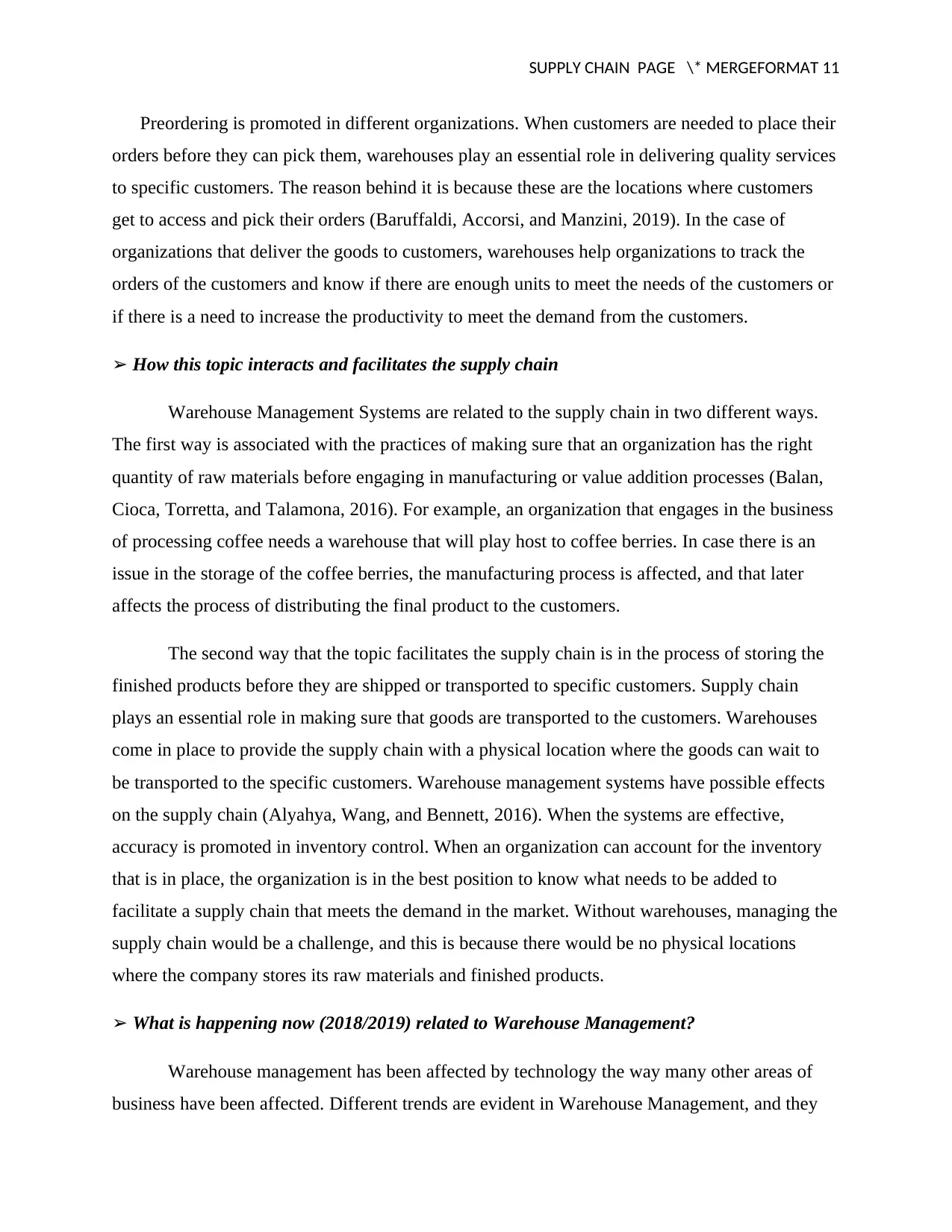
SUPPLY CHAIN PAGE \* MERGEFORMAT 11
Preordering is promoted in different organizations. When customers are needed to place their
orders before they can pick them, warehouses play an essential role in delivering quality services
to specific customers. The reason behind it is because these are the locations where customers
get to access and pick their orders (Baruffaldi, Accorsi, and Manzini, 2019). In the case of
organizations that deliver the goods to customers, warehouses help organizations to track the
orders of the customers and know if there are enough units to meet the needs of the customers or
if there is a need to increase the productivity to meet the demand from the customers.
➢ How this topic interacts and facilitates the supply chain
Warehouse Management Systems are related to the supply chain in two different ways.
The first way is associated with the practices of making sure that an organization has the right
quantity of raw materials before engaging in manufacturing or value addition processes (Balan,
Cioca, Torretta, and Talamona, 2016). For example, an organization that engages in the business
of processing coffee needs a warehouse that will play host to coffee berries. In case there is an
issue in the storage of the coffee berries, the manufacturing process is affected, and that later
affects the process of distributing the final product to the customers.
The second way that the topic facilitates the supply chain is in the process of storing the
finished products before they are shipped or transported to specific customers. Supply chain
plays an essential role in making sure that goods are transported to the customers. Warehouses
come in place to provide the supply chain with a physical location where the goods can wait to
be transported to the specific customers. Warehouse management systems have possible effects
on the supply chain (Alyahya, Wang, and Bennett, 2016). When the systems are effective,
accuracy is promoted in inventory control. When an organization can account for the inventory
that is in place, the organization is in the best position to know what needs to be added to
facilitate a supply chain that meets the demand in the market. Without warehouses, managing the
supply chain would be a challenge, and this is because there would be no physical locations
where the company stores its raw materials and finished products.
➢ What is happening now (2018/2019) related to Warehouse Management?
Warehouse management has been affected by technology the way many other areas of
business have been affected. Different trends are evident in Warehouse Management, and they
Preordering is promoted in different organizations. When customers are needed to place their
orders before they can pick them, warehouses play an essential role in delivering quality services
to specific customers. The reason behind it is because these are the locations where customers
get to access and pick their orders (Baruffaldi, Accorsi, and Manzini, 2019). In the case of
organizations that deliver the goods to customers, warehouses help organizations to track the
orders of the customers and know if there are enough units to meet the needs of the customers or
if there is a need to increase the productivity to meet the demand from the customers.
➢ How this topic interacts and facilitates the supply chain
Warehouse Management Systems are related to the supply chain in two different ways.
The first way is associated with the practices of making sure that an organization has the right
quantity of raw materials before engaging in manufacturing or value addition processes (Balan,
Cioca, Torretta, and Talamona, 2016). For example, an organization that engages in the business
of processing coffee needs a warehouse that will play host to coffee berries. In case there is an
issue in the storage of the coffee berries, the manufacturing process is affected, and that later
affects the process of distributing the final product to the customers.
The second way that the topic facilitates the supply chain is in the process of storing the
finished products before they are shipped or transported to specific customers. Supply chain
plays an essential role in making sure that goods are transported to the customers. Warehouses
come in place to provide the supply chain with a physical location where the goods can wait to
be transported to the specific customers. Warehouse management systems have possible effects
on the supply chain (Alyahya, Wang, and Bennett, 2016). When the systems are effective,
accuracy is promoted in inventory control. When an organization can account for the inventory
that is in place, the organization is in the best position to know what needs to be added to
facilitate a supply chain that meets the demand in the market. Without warehouses, managing the
supply chain would be a challenge, and this is because there would be no physical locations
where the company stores its raw materials and finished products.
➢ What is happening now (2018/2019) related to Warehouse Management?
Warehouse management has been affected by technology the way many other areas of
business have been affected. Different trends are evident in Warehouse Management, and they
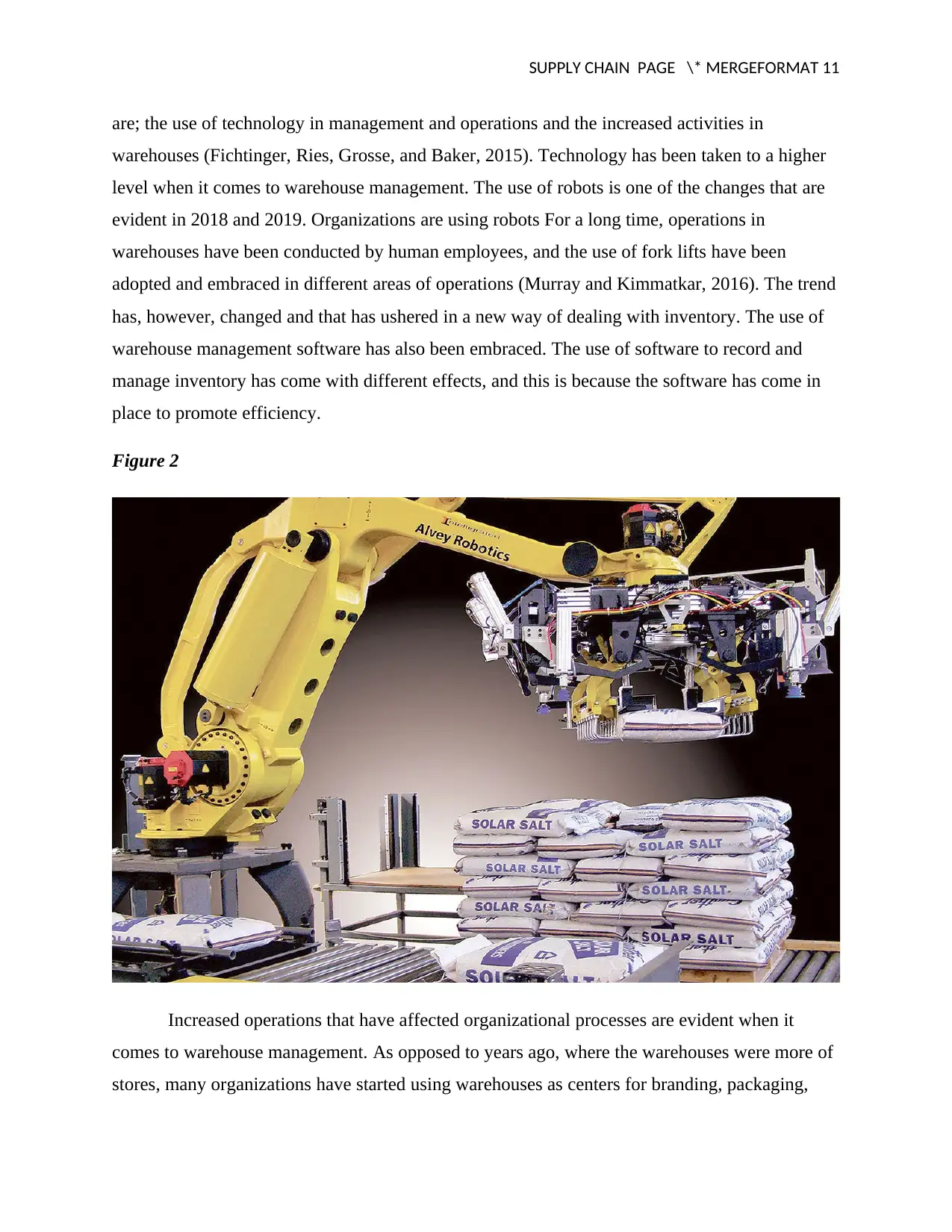
SUPPLY CHAIN PAGE \* MERGEFORMAT 11
are; the use of technology in management and operations and the increased activities in
warehouses (Fichtinger, Ries, Grosse, and Baker, 2015). Technology has been taken to a higher
level when it comes to warehouse management. The use of robots is one of the changes that are
evident in 2018 and 2019. Organizations are using robots For a long time, operations in
warehouses have been conducted by human employees, and the use of fork lifts have been
adopted and embraced in different areas of operations (Murray and Kimmatkar, 2016). The trend
has, however, changed and that has ushered in a new way of dealing with inventory. The use of
warehouse management software has also been embraced. The use of software to record and
manage inventory has come with different effects, and this is because the software has come in
place to promote efficiency.
Figure 2
Increased operations that have affected organizational processes are evident when it
comes to warehouse management. As opposed to years ago, where the warehouses were more of
stores, many organizations have started using warehouses as centers for branding, packaging,
are; the use of technology in management and operations and the increased activities in
warehouses (Fichtinger, Ries, Grosse, and Baker, 2015). Technology has been taken to a higher
level when it comes to warehouse management. The use of robots is one of the changes that are
evident in 2018 and 2019. Organizations are using robots For a long time, operations in
warehouses have been conducted by human employees, and the use of fork lifts have been
adopted and embraced in different areas of operations (Murray and Kimmatkar, 2016). The trend
has, however, changed and that has ushered in a new way of dealing with inventory. The use of
warehouse management software has also been embraced. The use of software to record and
manage inventory has come with different effects, and this is because the software has come in
place to promote efficiency.
Figure 2
Increased operations that have affected organizational processes are evident when it
comes to warehouse management. As opposed to years ago, where the warehouses were more of
stores, many organizations have started using warehouses as centers for branding, packaging,
Paraphrase This Document
Need a fresh take? Get an instant paraphrase of this document with our AI Paraphraser
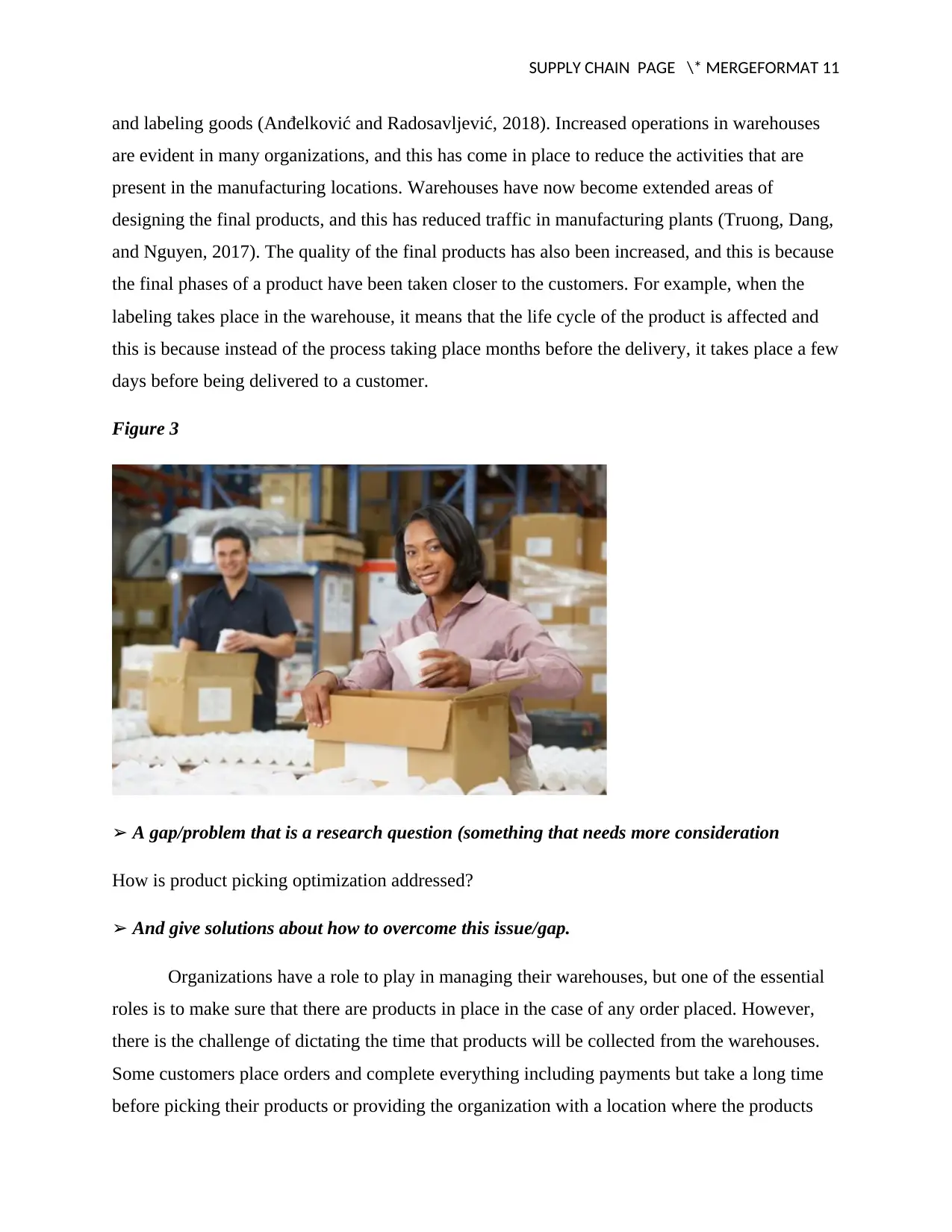
SUPPLY CHAIN PAGE \* MERGEFORMAT 11
and labeling goods (Anđelković and Radosavljević, 2018). Increased operations in warehouses
are evident in many organizations, and this has come in place to reduce the activities that are
present in the manufacturing locations. Warehouses have now become extended areas of
designing the final products, and this has reduced traffic in manufacturing plants (Truong, Dang,
and Nguyen, 2017). The quality of the final products has also been increased, and this is because
the final phases of a product have been taken closer to the customers. For example, when the
labeling takes place in the warehouse, it means that the life cycle of the product is affected and
this is because instead of the process taking place months before the delivery, it takes place a few
days before being delivered to a customer.
Figure 3
➢ A gap/problem that is a research question (something that needs more consideration
How is product picking optimization addressed?
➢ And give solutions about how to overcome this issue/gap.
Organizations have a role to play in managing their warehouses, but one of the essential
roles is to make sure that there are products in place in the case of any order placed. However,
there is the challenge of dictating the time that products will be collected from the warehouses.
Some customers place orders and complete everything including payments but take a long time
before picking their products or providing the organization with a location where the products
and labeling goods (Anđelković and Radosavljević, 2018). Increased operations in warehouses
are evident in many organizations, and this has come in place to reduce the activities that are
present in the manufacturing locations. Warehouses have now become extended areas of
designing the final products, and this has reduced traffic in manufacturing plants (Truong, Dang,
and Nguyen, 2017). The quality of the final products has also been increased, and this is because
the final phases of a product have been taken closer to the customers. For example, when the
labeling takes place in the warehouse, it means that the life cycle of the product is affected and
this is because instead of the process taking place months before the delivery, it takes place a few
days before being delivered to a customer.
Figure 3
➢ A gap/problem that is a research question (something that needs more consideration
How is product picking optimization addressed?
➢ And give solutions about how to overcome this issue/gap.
Organizations have a role to play in managing their warehouses, but one of the essential
roles is to make sure that there are products in place in the case of any order placed. However,
there is the challenge of dictating the time that products will be collected from the warehouses.
Some customers place orders and complete everything including payments but take a long time
before picking their products or providing the organization with a location where the products
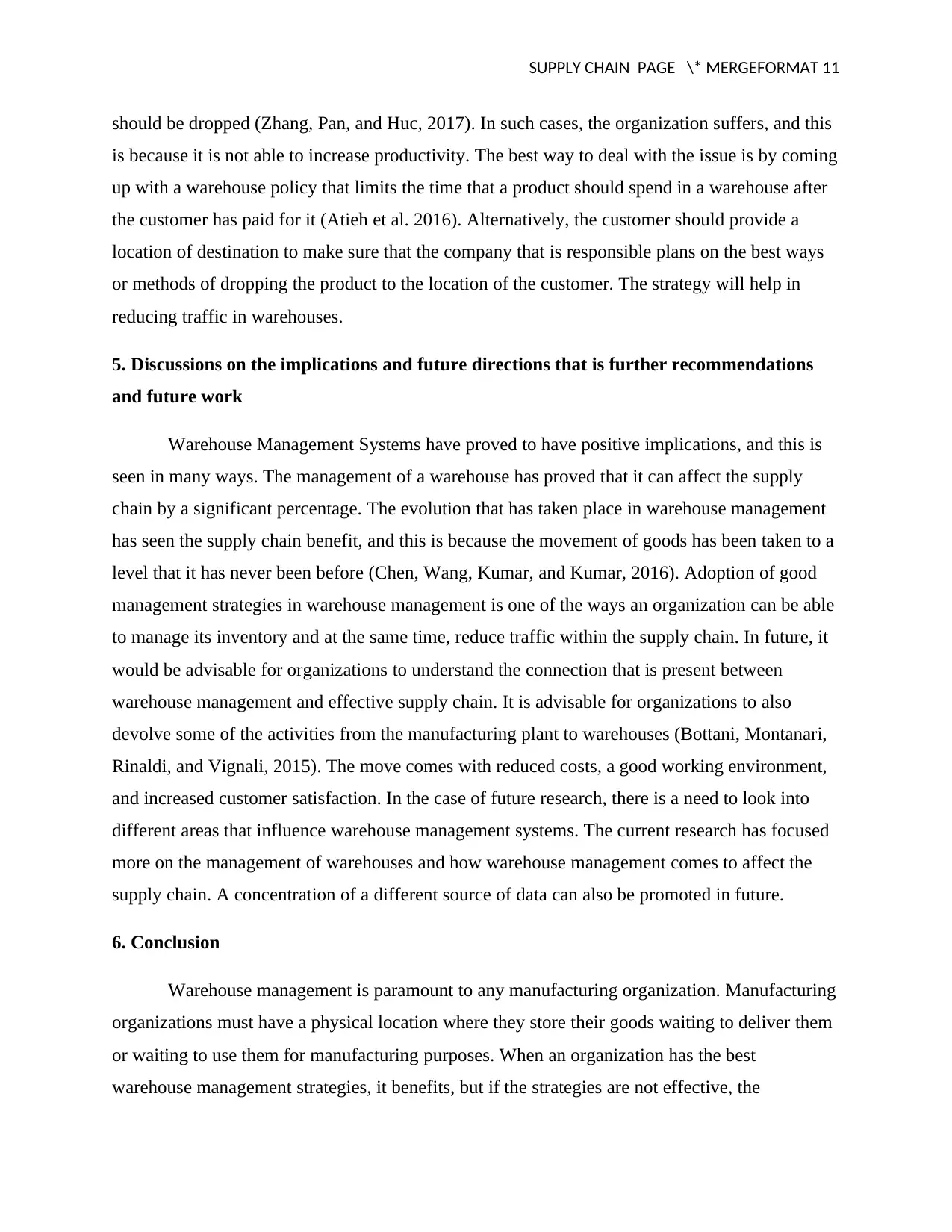
SUPPLY CHAIN PAGE \* MERGEFORMAT 11
should be dropped (Zhang, Pan, and Huc, 2017). In such cases, the organization suffers, and this
is because it is not able to increase productivity. The best way to deal with the issue is by coming
up with a warehouse policy that limits the time that a product should spend in a warehouse after
the customer has paid for it (Atieh et al. 2016). Alternatively, the customer should provide a
location of destination to make sure that the company that is responsible plans on the best ways
or methods of dropping the product to the location of the customer. The strategy will help in
reducing traffic in warehouses.
5. Discussions on the implications and future directions that is further recommendations
and future work
Warehouse Management Systems have proved to have positive implications, and this is
seen in many ways. The management of a warehouse has proved that it can affect the supply
chain by a significant percentage. The evolution that has taken place in warehouse management
has seen the supply chain benefit, and this is because the movement of goods has been taken to a
level that it has never been before (Chen, Wang, Kumar, and Kumar, 2016). Adoption of good
management strategies in warehouse management is one of the ways an organization can be able
to manage its inventory and at the same time, reduce traffic within the supply chain. In future, it
would be advisable for organizations to understand the connection that is present between
warehouse management and effective supply chain. It is advisable for organizations to also
devolve some of the activities from the manufacturing plant to warehouses (Bottani, Montanari,
Rinaldi, and Vignali, 2015). The move comes with reduced costs, a good working environment,
and increased customer satisfaction. In the case of future research, there is a need to look into
different areas that influence warehouse management systems. The current research has focused
more on the management of warehouses and how warehouse management comes to affect the
supply chain. A concentration of a different source of data can also be promoted in future.
6. Conclusion
Warehouse management is paramount to any manufacturing organization. Manufacturing
organizations must have a physical location where they store their goods waiting to deliver them
or waiting to use them for manufacturing purposes. When an organization has the best
warehouse management strategies, it benefits, but if the strategies are not effective, the
should be dropped (Zhang, Pan, and Huc, 2017). In such cases, the organization suffers, and this
is because it is not able to increase productivity. The best way to deal with the issue is by coming
up with a warehouse policy that limits the time that a product should spend in a warehouse after
the customer has paid for it (Atieh et al. 2016). Alternatively, the customer should provide a
location of destination to make sure that the company that is responsible plans on the best ways
or methods of dropping the product to the location of the customer. The strategy will help in
reducing traffic in warehouses.
5. Discussions on the implications and future directions that is further recommendations
and future work
Warehouse Management Systems have proved to have positive implications, and this is
seen in many ways. The management of a warehouse has proved that it can affect the supply
chain by a significant percentage. The evolution that has taken place in warehouse management
has seen the supply chain benefit, and this is because the movement of goods has been taken to a
level that it has never been before (Chen, Wang, Kumar, and Kumar, 2016). Adoption of good
management strategies in warehouse management is one of the ways an organization can be able
to manage its inventory and at the same time, reduce traffic within the supply chain. In future, it
would be advisable for organizations to understand the connection that is present between
warehouse management and effective supply chain. It is advisable for organizations to also
devolve some of the activities from the manufacturing plant to warehouses (Bottani, Montanari,
Rinaldi, and Vignali, 2015). The move comes with reduced costs, a good working environment,
and increased customer satisfaction. In the case of future research, there is a need to look into
different areas that influence warehouse management systems. The current research has focused
more on the management of warehouses and how warehouse management comes to affect the
supply chain. A concentration of a different source of data can also be promoted in future.
6. Conclusion
Warehouse management is paramount to any manufacturing organization. Manufacturing
organizations must have a physical location where they store their goods waiting to deliver them
or waiting to use them for manufacturing purposes. When an organization has the best
warehouse management strategies, it benefits, but if the strategies are not effective, the
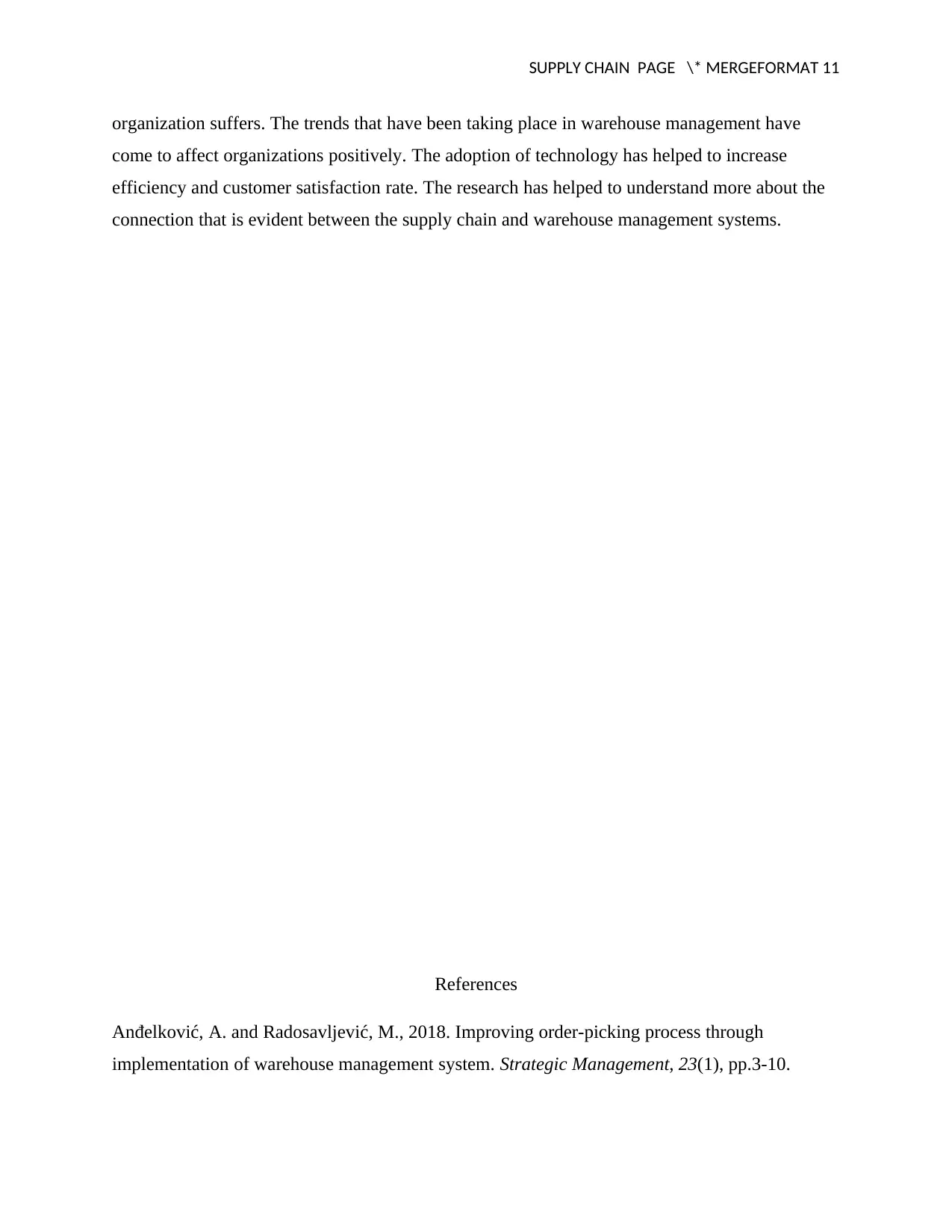
SUPPLY CHAIN PAGE \* MERGEFORMAT 11
organization suffers. The trends that have been taking place in warehouse management have
come to affect organizations positively. The adoption of technology has helped to increase
efficiency and customer satisfaction rate. The research has helped to understand more about the
connection that is evident between the supply chain and warehouse management systems.
References
Anđelković, A. and Radosavljević, M., 2018. Improving order-picking process through
implementation of warehouse management system. Strategic Management, 23(1), pp.3-10.
organization suffers. The trends that have been taking place in warehouse management have
come to affect organizations positively. The adoption of technology has helped to increase
efficiency and customer satisfaction rate. The research has helped to understand more about the
connection that is evident between the supply chain and warehouse management systems.
References
Anđelković, A. and Radosavljević, M., 2018. Improving order-picking process through
implementation of warehouse management system. Strategic Management, 23(1), pp.3-10.
Secure Best Marks with AI Grader
Need help grading? Try our AI Grader for instant feedback on your assignments.
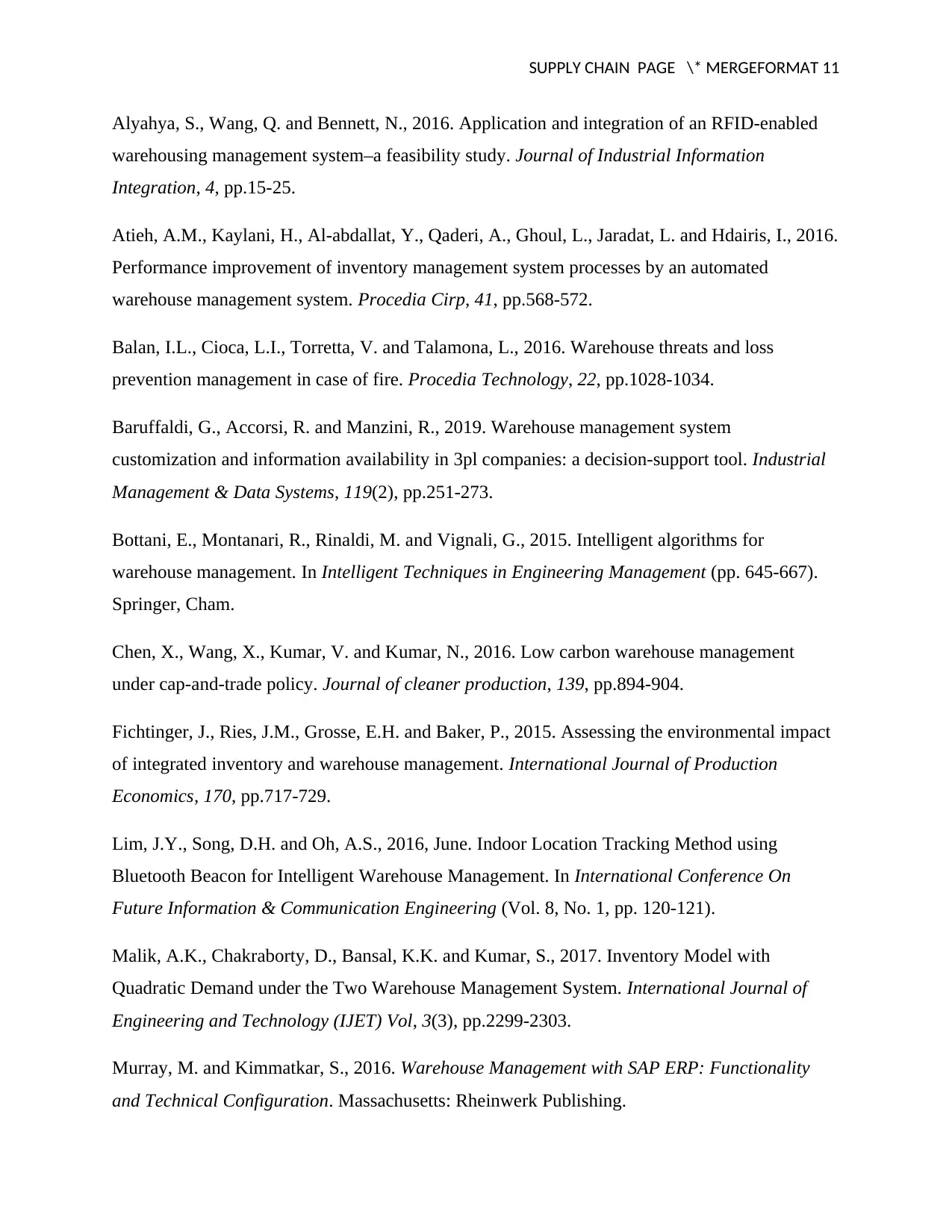
SUPPLY CHAIN PAGE \* MERGEFORMAT 11
Alyahya, S., Wang, Q. and Bennett, N., 2016. Application and integration of an RFID-enabled
warehousing management system–a feasibility study. Journal of Industrial Information
Integration, 4, pp.15-25.
Atieh, A.M., Kaylani, H., Al-abdallat, Y., Qaderi, A., Ghoul, L., Jaradat, L. and Hdairis, I., 2016.
Performance improvement of inventory management system processes by an automated
warehouse management system. Procedia Cirp, 41, pp.568-572.
Balan, I.L., Cioca, L.I., Torretta, V. and Talamona, L., 2016. Warehouse threats and loss
prevention management in case of fire. Procedia Technology, 22, pp.1028-1034.
Baruffaldi, G., Accorsi, R. and Manzini, R., 2019. Warehouse management system
customization and information availability in 3pl companies: a decision-support tool. Industrial
Management & Data Systems, 119(2), pp.251-273.
Bottani, E., Montanari, R., Rinaldi, M. and Vignali, G., 2015. Intelligent algorithms for
warehouse management. In Intelligent Techniques in Engineering Management (pp. 645-667).
Springer, Cham.
Chen, X., Wang, X., Kumar, V. and Kumar, N., 2016. Low carbon warehouse management
under cap-and-trade policy. Journal of cleaner production, 139, pp.894-904.
Fichtinger, J., Ries, J.M., Grosse, E.H. and Baker, P., 2015. Assessing the environmental impact
of integrated inventory and warehouse management. International Journal of Production
Economics, 170, pp.717-729.
Lim, J.Y., Song, D.H. and Oh, A.S., 2016, June. Indoor Location Tracking Method using
Bluetooth Beacon for Intelligent Warehouse Management. In International Conference On
Future Information & Communication Engineering (Vol. 8, No. 1, pp. 120-121).
Malik, A.K., Chakraborty, D., Bansal, K.K. and Kumar, S., 2017. Inventory Model with
Quadratic Demand under the Two Warehouse Management System. International Journal of
Engineering and Technology (IJET) Vol, 3(3), pp.2299-2303.
Murray, M. and Kimmatkar, S., 2016. Warehouse Management with SAP ERP: Functionality
and Technical Configuration. Massachusetts: Rheinwerk Publishing.
Alyahya, S., Wang, Q. and Bennett, N., 2016. Application and integration of an RFID-enabled
warehousing management system–a feasibility study. Journal of Industrial Information
Integration, 4, pp.15-25.
Atieh, A.M., Kaylani, H., Al-abdallat, Y., Qaderi, A., Ghoul, L., Jaradat, L. and Hdairis, I., 2016.
Performance improvement of inventory management system processes by an automated
warehouse management system. Procedia Cirp, 41, pp.568-572.
Balan, I.L., Cioca, L.I., Torretta, V. and Talamona, L., 2016. Warehouse threats and loss
prevention management in case of fire. Procedia Technology, 22, pp.1028-1034.
Baruffaldi, G., Accorsi, R. and Manzini, R., 2019. Warehouse management system
customization and information availability in 3pl companies: a decision-support tool. Industrial
Management & Data Systems, 119(2), pp.251-273.
Bottani, E., Montanari, R., Rinaldi, M. and Vignali, G., 2015. Intelligent algorithms for
warehouse management. In Intelligent Techniques in Engineering Management (pp. 645-667).
Springer, Cham.
Chen, X., Wang, X., Kumar, V. and Kumar, N., 2016. Low carbon warehouse management
under cap-and-trade policy. Journal of cleaner production, 139, pp.894-904.
Fichtinger, J., Ries, J.M., Grosse, E.H. and Baker, P., 2015. Assessing the environmental impact
of integrated inventory and warehouse management. International Journal of Production
Economics, 170, pp.717-729.
Lim, J.Y., Song, D.H. and Oh, A.S., 2016, June. Indoor Location Tracking Method using
Bluetooth Beacon for Intelligent Warehouse Management. In International Conference On
Future Information & Communication Engineering (Vol. 8, No. 1, pp. 120-121).
Malik, A.K., Chakraborty, D., Bansal, K.K. and Kumar, S., 2017. Inventory Model with
Quadratic Demand under the Two Warehouse Management System. International Journal of
Engineering and Technology (IJET) Vol, 3(3), pp.2299-2303.
Murray, M. and Kimmatkar, S., 2016. Warehouse Management with SAP ERP: Functionality
and Technical Configuration. Massachusetts: Rheinwerk Publishing.
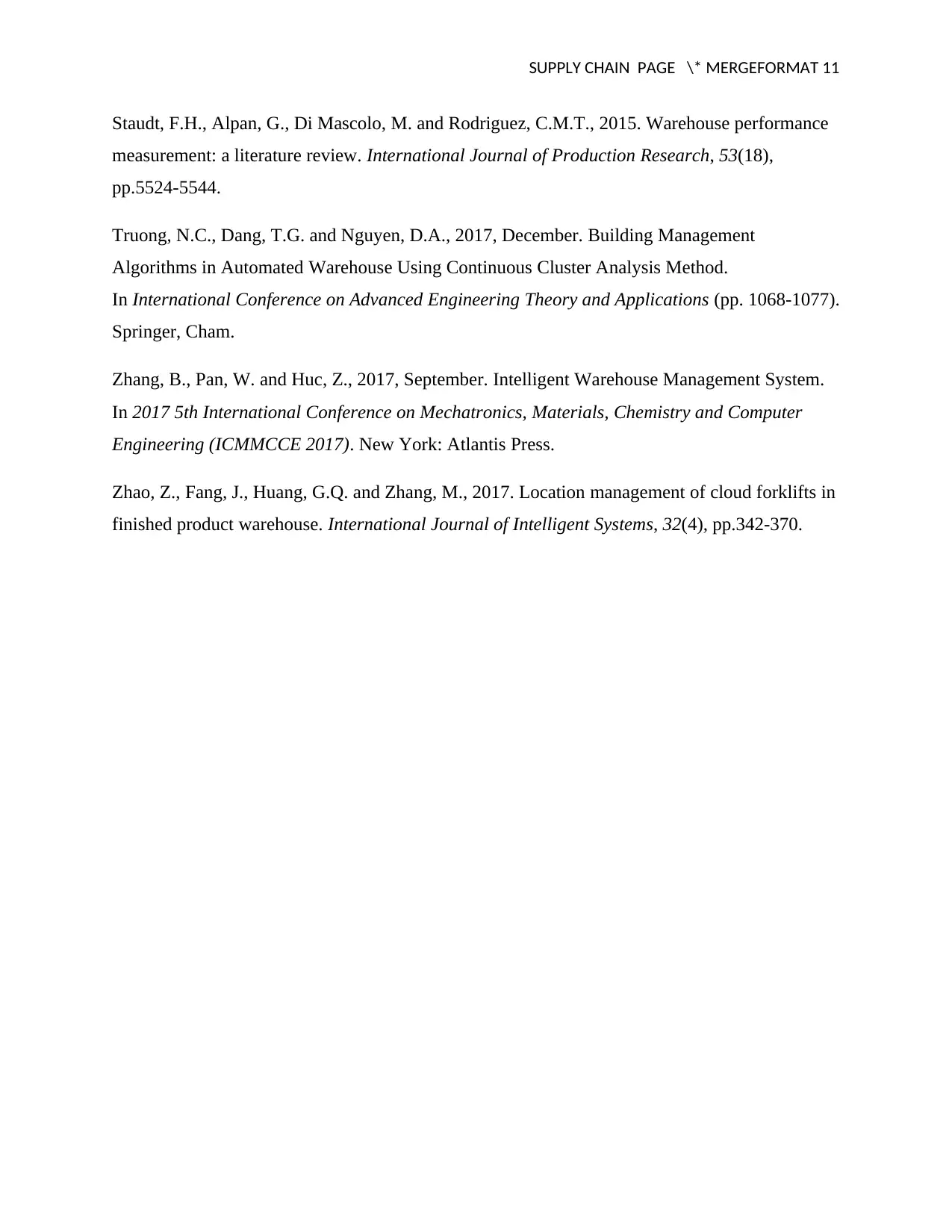
SUPPLY CHAIN PAGE \* MERGEFORMAT 11
Staudt, F.H., Alpan, G., Di Mascolo, M. and Rodriguez, C.M.T., 2015. Warehouse performance
measurement: a literature review. International Journal of Production Research, 53(18),
pp.5524-5544.
Truong, N.C., Dang, T.G. and Nguyen, D.A., 2017, December. Building Management
Algorithms in Automated Warehouse Using Continuous Cluster Analysis Method.
In International Conference on Advanced Engineering Theory and Applications (pp. 1068-1077).
Springer, Cham.
Zhang, B., Pan, W. and Huc, Z., 2017, September. Intelligent Warehouse Management System.
In 2017 5th International Conference on Mechatronics, Materials, Chemistry and Computer
Engineering (ICMMCCE 2017). New York: Atlantis Press.
Zhao, Z., Fang, J., Huang, G.Q. and Zhang, M., 2017. Location management of cloud forklifts in
finished product warehouse. International Journal of Intelligent Systems, 32(4), pp.342-370.
Staudt, F.H., Alpan, G., Di Mascolo, M. and Rodriguez, C.M.T., 2015. Warehouse performance
measurement: a literature review. International Journal of Production Research, 53(18),
pp.5524-5544.
Truong, N.C., Dang, T.G. and Nguyen, D.A., 2017, December. Building Management
Algorithms in Automated Warehouse Using Continuous Cluster Analysis Method.
In International Conference on Advanced Engineering Theory and Applications (pp. 1068-1077).
Springer, Cham.
Zhang, B., Pan, W. and Huc, Z., 2017, September. Intelligent Warehouse Management System.
In 2017 5th International Conference on Mechatronics, Materials, Chemistry and Computer
Engineering (ICMMCCE 2017). New York: Atlantis Press.
Zhao, Z., Fang, J., Huang, G.Q. and Zhang, M., 2017. Location management of cloud forklifts in
finished product warehouse. International Journal of Intelligent Systems, 32(4), pp.342-370.
1 out of 12
Related Documents
Your All-in-One AI-Powered Toolkit for Academic Success.
+13062052269
info@desklib.com
Available 24*7 on WhatsApp / Email
![[object Object]](/_next/static/media/star-bottom.7253800d.svg)
Unlock your academic potential
© 2024 | Zucol Services PVT LTD | All rights reserved.





